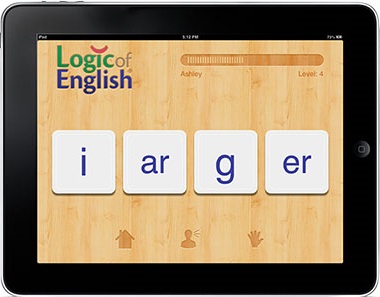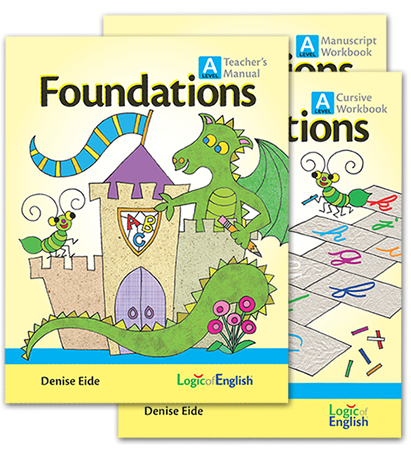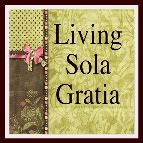
Logic of English is a fun, multi-sensory program that takes a systematic approach to teaching reading, writing, spelling and grammar. Logic of English was created by home school mom and ESL teacher, Denise Eide, as she searched for a program to help her own struggling readers and spellers.
There are several components of the Logic of English curriculum, that accomidate varying ages and skill levels. We were given Foundations Level A, which teaches students letters A-Z and consonant blends, for review.
Foundations is geared for students ages 4-7. This curriculum has four levels, A, B, C and D. Level A, the one are reviewing, is for beginning readers. The following products were sent to us for our review:
- Foundations Level A - Teacher's Manual and Manuscript Workbook (cursive is also available) $56.00
- Foundations Reusable Resource Set - which includes Phonogram Flash Cards, a Student Whiteboard, Tactile Handwriting Cards, 2 Sets of Phonogram Card Games. The cost of this set is $40.00
- Phonograms App - available for iPads, iPods and iPhones through iTunes for $2.99
The Foundations Level A Teacher's Manual and Manuscript Workbook contain 40 lessons that offer a various learning games and activities. The teacher manual is very user friendly, I think it is laid out nicely and easy to understand. The student workbook is a colorful, attractive and fun to use book. It includes phonics activity pages, handwriting pages, pull out reader books and games. Some of the games include blending games, phonogram bingo, phonogram tic-tac-toe, and charades.
Let me walk you through one of the lessons to give you a feel for how they are laid out. At the top of each lesson you can read the lesson objectives for handwriting, phonemic awareness and what Common Core Standards they are meeting, along with the matierals needed.
Lesson 9 focuses on the phonogram C, listening to the beginning sounds of words and practicing blending sounds into words.
First you would start with phonometic awareness and work on beginning sounds. The student would open their workbook to lesson 9. As you read beginning sounds like ch in chair and d in desk they would find the picture that begins with that sound. There is also a fun challenge to do. You would say a sound like d, and have students find an item in the room that start with that sound like a desk or a door.
Next, you and your child would move onto a blending treasure hunt. As a word is sounded out, your child would run and find that object. Like if I sounded out p-e-n-s-i-l, they would go and grab a pencil.
You would then spend some time on phonograms. You would practice all prior phonograms learned up until this point, and learn the phonogram c. I love that each time you learn a new letter sound she gives you fun ideas to go along with that letter. For c she suggests eating cake, carrots, ice cream cones, cabbage or corn. Kids could play cars, pretend they are camping, practice counting or cut out circles.
After learning the sound of the letter c, now your child will learn how to write it. The Foundations currciulum encourages starting with cursive handwriting, but also offers manuscript workbooks. The teacher manual gives instructions for both cursive and manuscript. The teacher manual gives step by step instructions for forming each letter. The tactile cards are also helpful at this point, students can practice tracing the letter c with their finger.
Last, but certainly not least is the phonogram practice section. This section is kinda like the cherry on top of a sundae! In other words, for the kids it's the best part. This part of the lesson includes games like phonogram aerobics, where kids practice writing their letters as big as they can in the air. Phonogram hopscotch (both indoor and outdoor versions included) and a phonogram relay race. My kids love these active games and I am a firm believer that kids learn best when they are actively doing something. I really appreciate that she has included these games to help reinforce what the children are learning!
I hope that gives you a general idea as to how Foundations is laid out. Not everyday is the same, some days include reading and spelling practice, and there are many different games and multi-sensory activites sprinkled through out the curriculum.
You can view a few sample lessons (samples are on the right side column), as well as the scope and sequence here.
I like Foundations. It does require a fair amount of one on one teaching time, as do most reading programs. I feel that it is a solid, well rounded program that include lots of interactive, hand-ons activities that are wonderful for active children. This is one of those programs that children look forward to doing. Mrs. Eide has done a great job in combining phonic skills with fun activities.
You can view a few sample lessons (samples are on the right side column), as well as the scope and sequence here.
I like Foundations. It does require a fair amount of one on one teaching time, as do most reading programs. I feel that it is a solid, well rounded program that include lots of interactive, hand-ons activities that are wonderful for active children. This is one of those programs that children look forward to doing. Mrs. Eide has done a great job in combining phonic skills with fun activities.

We have also enjoyed using the Logic of English App called Phonics with Phonograms. This App has a pretty simple format, it kind of reminds be of electronic flash cards. It is an interactive way to practice phonograms, but I think my son would have liked it better if it were a game. He didn't dislike it, it just didn't seem to be something to hold his interest for very long. It does however get the job done.
I would recommend Foundations. As I said, it is a solid program with lots of fun hands on activities for phonetic practice. My only hesitation is the price. I felt it was a little on the high side. But in saying that, she has eliminated a lot of work for mom. I am always looking for fun things to add to our phonics program, but with Foundations the work is already done that for me.









1 comments:
Use confidence boosters before your next play bazaar presentation. Use mental imagery, calming techniques, and strong posture to satta king make yourself feel more confident.
Post a Comment